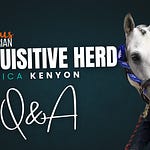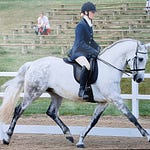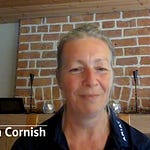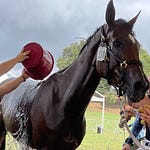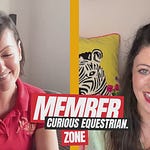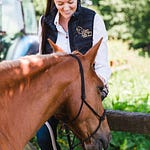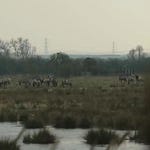In February 2018, passionate show jumper and entrepreneur Aisling Byrne was walking a horse back from an arena in Portugal when a passing tractor startled the animal. In an instant, the horse reared up and flipped over, landing squarely on top of her. The freak accident crushed her midsection, breaking both hips, shattering her pelvis, damaging her spine, and causing severe internal injuries.
When she arrived at hospital, doctors delivered a devastating prognosis: Aisling would never walk again. She would be wheelchair-bound for life.
Yet seven years later, against all medical expectations, Aisling is not only walking but competing internationally in show jumping once again. Her journey offers remarkable insights into resilience, the healing power of the horse-human connection, and finding a new perspective in the face of life-altering trauma.
Not yet part of our Inquisitive Herd? Above you'll find a 1-minute preview of our conversation with Annabelle Holmes. Join our community today to watch the complete interview ad-free and access our library of exclusive content on sustainable horse care.
Or watch free with ads on our YouTube Channel
A Life Suddenly Interrupted
Prior to the accident, Aisling's life was exceptionally busy. In our recent conversation, she described juggling multiple careers with her equestrian ambitions.
"Life was so busy back then," Aisling explained during our interview. "I had a travel company, a luxurious Ireland and Scotland travel company, where we bring American and Canadian clients touring around those countries. I was doing a lot of modelling at the time, working with a very good agency in Ireland. And then I was competing a lot with the horses."
She had set ambitious goals for that year, building "a really solid, good string of quality horses" as she prepared to step up to a higher competition level. All those plans came to an abrupt halt the moment the horse landed on her.
What's perhaps most striking about Aisling's recollection of the accident is her remarkable composure during the crisis. Even with catastrophic injuries, she remained conscious and unexpectedly calm.
"I had a moment of sheer panic thinking, you know, what am I going to do?" she told us. "And as soon as I realised, okay, I can't move, I just thought it's gonna be a long day. The best thing I can do now is reserve energy, and just wait for help to come."
The Long Road Back
The extent of Aisling's injuries was severe. "I had completely crushed my pelvis," she explained. "My organs had moved out of places that they should have been. I had broken the bottom of my spine."
The initial surgery in Portugal was life-saving but left her with an extremely difficult prognosis. Doctors told her she wouldn't walk again and would be wheelchair-bound for life. They also said she wouldn't be able to have children, though they later revised that assessment.
After being transferred to a specialist hospital in Dublin, Aisling underwent additional surgeries that began to put her "back together again," as she described it. With metal implants replacing her external fixators, she could finally begin physiotherapy.
The road to recovery was neither quick nor straightforward. "There were more steps backwards than forwards for a long time," Aisling shared. "There was no set plan of how to overcome these injuries because they're not typical injuries."
Even when she visited a specialist sports physiotherapist, she was told to forget about ever riding again. But Aisling's mother offered a different perspective, reminding her that Nick Skelton had broken his neck, been told he'd never ride again, and went on to win an Olympic gold medal.
The Determination to Ride
Throughout her gruelling recovery, one goal remained constant for Aisling: to sit on a horse again and look through their ears.
"At a bare minimum, that was my goal," she said. "It really upset me to think that I wouldn't be able to do that."
After two and a half years – still on crutches – Aisling's opportunity finally came. Her family prepared her first show jumping pony, now retired, for a momentous reunion.
"My dad got a forklift in the yard and I stood onto the front of it," she recalled. "He lifted me up on it so I could sit down on her. I didn't have to swing my hips to get on her. I was the happiest person in the world just to be able to sit on her, look out over her ears."
The emotional significance of this moment was heightened by the fact that this was the very pony that had started her show jumping journey as a child.
"It did feel like a bit of a full circle moment," Aisling told us. "The fact that she was my first show jumping pony, and she was helping me on my recovery again."
Relearning to Ride with a Different Body
Returning to competition presented unique challenges. Aisling's injuries had permanently changed her body mechanics.
"My left leg is a lot weaker now," she explained. "I sit differently in the saddle because my pelvis doesn't sit the same, so I sit a bit tilted. I have a lot of things that I need to compensate for."
What amazed her was how her horses adapted to these changes. "They have each of them adapted," she said with evident wonder. "They all are so intuitive."
Without the same physical strength and balance she once had, Aisling developed new ways to communicate with her horses. For one particular mount who could get "unruly in his head," she discovered that talking to him during competition made a profound difference.
"I'll talk him around the course," she shared. "If he's getting a bit unruly in his head, I'll just talk to him and I'll feel his whole body relax. He'll focus on the fence and we'll get the shot we want."
This deeper connection with her horses has become one of the unexpected gifts of her recovery journey.
A New Perspective in the Saddle
Perhaps the most profound change for Aisling has been her mental approach to riding and competition. Before the accident, she described herself as a perfectionist who would dwell on mistakes. Now, she finds herself more appreciative and present in the moment.
"I had a whole new appreciation for being able to do the sport, for being able to work with these animals," she reflected. "I do try and actively remind myself of that. Four faults is not a bad day, you know, it's only a fence."
This shift in mindset has actually improved her performance. "I stay more in the moment now, when I'm jumping and things flow better for me," she explained. "Before I would have been very, you know, wanted everything to be perfect, very much perfectionist. If I was a touch too deep to a fence, it'd still be bothering me probably at the next fence without me realizing."
The result? "I'm actually riding faster rounds than ever," she told us with a laugh.
Kindness as a Training Philosophy
Throughout our conversation, Aisling repeatedly emphasized the importance of kindness in her approach to horses – a philosophy that has only deepened since her accident.
"I'm very kind to the horses and in turn, they're very kind to me," she said. "I do feel like they sense that and want to do a good job for me."
She believes this reciprocal relationship creates better results than force or pressure ever could: "I just find you get a hell of a lot more from a happy, content horse who wants to do it for you and is on your side as a team."
For Aisling, understanding each horse's unique personality is essential. "They're like people, they have their personalities," she observed. "The joy for me is to figure out what they like, and keep them happy."
When looking for qualities in her show jumpers, Aisling values character above all. "Once they have a good head, a good mind, that's normally most important for me," she explained. "I love a quirky horse, and I have loads of patience."
Life After the Fall
Seven years after the accident that nearly took her life, Aisling has rebuilt her life around the horses she loves. When we spoke, she was competing in Spain with what she described as "a lovely group of horses."
Her perspective on riding has been transformed by her experience. When asked if riders should be more cautious given the risks, her answer was definitive: "Carry on in blissful ignorance. Enjoy the moment. Stay in the moment."
She believes that overly cautious, defensive riding actually increases the likelihood of accidents. Instead, she advocates for living fully in the present: "Life is for living. It is. Try your hand at it, you know, try the new horse, and do all these things."
The wisdom Aisling carries from her experience is something she hopes might help others facing their own challenges.
"Life is full of ups and downs, that is what life is," she reflected. "I am of the belief that these downs or these hurdles are there to teach you something or to send you in a different direction."
For Aisling Byrne, the path has led her back to where she always wanted to be – looking through a horse's ears, competing at the highest levels, but with a profoundly different perspective on what matters most.
"Don't sweat the small stuff," she concluded. "Just focus on the things you're enjoying. You'll get more of them."
Connect with Aisling Byrne
For those inspired by Aisling’s story and wanting to follow her ongoing journey, she is active on social media. You can find her primarily on Instagram and TikTok under the handle @aislingbyrne1. Her presence there offers insights into her life, training, and passion for horses.
Her experience and outlook provide invaluable lessons for equestrians and non-equestrians alike, reminding us all of the power of resilience, kindness, and living fully in the moment.
Thank you for being part of our Inquisitive Herd! We appreciate your support that allows us to create ad-free content like our interview with Annabelle Holmes. As a member, you can enjoy the full episode without interruptions and access our exclusive playlist of member-only extended interviews and bonus content.




